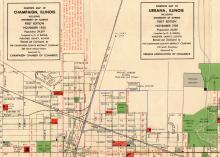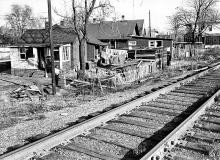
Among the papers in the recently processed League of Women Voters Collection is a document titled “Champaign-Urbana Shack Study,” dated March 1949. Completed by the Social Welfare Committee of the LWV, it describes the living conditions in a northern Champaign-Urbana neighborhood bordered by the railroad tracks and Bradley, Goodwin, and Washington streets. At the time, the area was unincorporated by both cities, and disputes about the construction of sewers halted development in the area. Home to low-income families, many of them African-American, the living conditions described in the report are appalling, describing converted chicken coops and coal sheds into one- or two-room shacks that held families of four or more. There was no running water, no electricity, and infestations of rats, termites, and other vermin.
In July 1949, one of the dwellings caught on fire, possibly from makeshift electrical wiring strung across a grape arbor and into the house. Clinton Young, 18, and his pregnant wife, Annie Lee, 15, both perished in the blaze. Although there was public outcry at the tragedy (mostly in the form of letters to the editor in local papers), the League of Women Voters became exceptionally vocal in their condemnation of these living conditions. The authors cited in their report the “fire hazards, the sanitation problems, and the psychological hazards of crowding,” as well as noting that the low tax valuation of the property in the area was insufficient to cover schooling, police protection, or other tax-supported services.
 Conditions were slow to change, however. In 1951, the LWV released another document, “Public Housing and Slum Clearance in Champaign-Urbana,” citing that the “slums and blighted areas require 45% of city service costs yet they yield only 6% of the tax revenue," and this was in spite of the high rent prices for the dwellings. The document makes ten recommendations for social and economic improvements to combat the presence of these slums. In the mid-1950s, officials sought federal grants to remove the substandard housing, hastened by another tragedy in May 1954 involving a house fire that killed two children, aged 2 and 3 years old.
Conditions were slow to change, however. In 1951, the LWV released another document, “Public Housing and Slum Clearance in Champaign-Urbana,” citing that the “slums and blighted areas require 45% of city service costs yet they yield only 6% of the tax revenue," and this was in spite of the high rent prices for the dwellings. The document makes ten recommendations for social and economic improvements to combat the presence of these slums. In the mid-1950s, officials sought federal grants to remove the substandard housing, hastened by another tragedy in May 1954 involving a house fire that killed two children, aged 2 and 3 years old.
A subsequent report by the LWV in 1968 noted that living conditions had improved for African-Americans in Champaign-Urbana as the result of the federal Civil Rights Act and local pressure from the Citizen’s Advisory Committee. It also sites that the University had difficulty “recruiting black faculty and staff because of the unavailability of housing outside of ghetto areas.” The 1968 report notes, however, that segregated neighborhoods were still common in Champaign-Urbana.
The League of Women Voters Collection documents the public output, civic involvement activities, press coverage, and administrative functions of the LWVCC. As a source of political information to Champaign County’s voting public, this collection provides insight into the group’s community commitment and accomplishments.
-Sarah L., Archives Assistant
